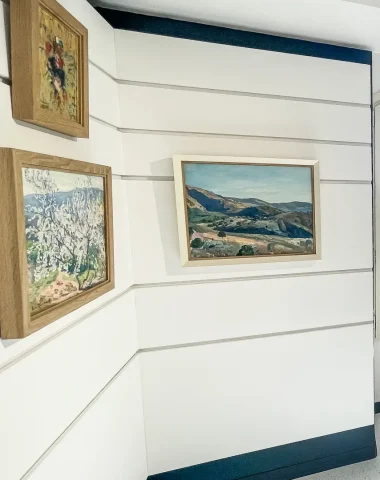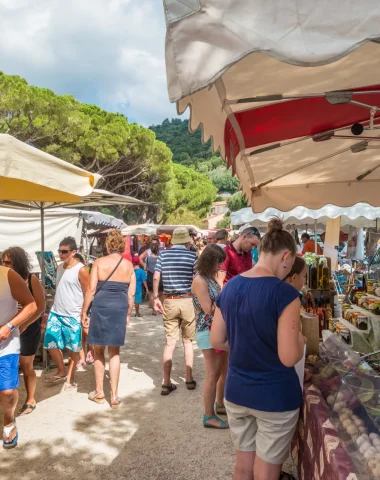Embark on a captivating journey along the Chemin des Sages, a project born from a visionary gathering of the Conseil des Sages, composed of wise individuals aged 60 and above, carefully chosen by local councilors for their wealth of experience. Inspired by the core principles of our Republican motto “Liberté, Égalité, Fraternité,” the council sought to breathe life into these ideals in the town of Bormes.
The Concept Takes Flight
A groundbreaking idea emerged during the council’s meeting—to adorn the town with phrases from renowned men and women, celebrated worldwide for their wisdom and humanism. The goal was to ignite the conscience of both passers-by and tourists, fostering a deeper connection with these universal values. To gain the support of the Mayor and the Council, the decision was made to integrate this pathway with the installation of historical plaques on the town’s iconic monuments. The members of the Conseil des Sages then meticulously designed the route through the medieval village and dedicated themselves to creating the perfect support, texts, images, and symbols for these plaques.

The butterfly, symbolizing joy, beauty, grace, and lightness of being, was chosen as the emblem of the project. Its transformative journey mirrors the essence of personal growth and rebirth. Just like the butterfly, we too experience different stages in life—a profound metamorphosis that allows us to release our past and embrace the beauty of who we’ve become. Symbolizing wisdom, the butterfly becomes a boundless source of inspiration. Beneath its delicate exterior lies an unwavering strength. Despite its ephemeral lifespan of a few days or weeks, the butterfly brings joy and exuberance through its graceful flight, fully savoring every moment that nature presents. Let us, like the butterfly, fearlessly embrace the experiences life offers us, both good and bad, knowing that they are fleeting. After all, our past experiences provide the best preparation for the future, allowing us to tread life’s paths with serenity
The biography of Marie Curie
Double Nobel Prize winner in physics and chemistry, and the first woman to win a Nobel Prize.
Marie Curie, born as Maria Sklodowska on November 7, 1867, in Warsaw, hailed from a family of patriotic and well-educated teachers. Enduring the oppressive Russian occupation and facing financial hardships, she demonstrated remarkable determination and strength from a young age. Driven by her passion for science, Maria dreamt of a great career in the field. She supported her sister Bronia in becoming a doctor, working as a schoolteacher until she could join her sister in Paris in 1891.

In Paris, Maria pursued her studies at the Sorbonne, excelling in both physics and mathematics. It was there that she met and married Pierre Curie, a fellow scientist who shared her passion. Together, they delved into research on natural uranium radiation, which led to the discovery of the previously unknown radioactive elements, polonium and radium. Their groundbreaking work earned them the Nobel Prize in Physics in 1903, with Marie becoming the first woman to receive such an honor.
Tragedy struck when Pierre Curie was killed in an accident in 1906, leaving Marie to raise their two daughters alone. Despite her grief, she courageously assumed her husband’s teaching position at the Sorbonne, becoming the first woman to hold such a chair. Continuing her research on radium, she earned another Nobel Prize, this time in Chemistry, in 1911, making her the only person to receive two such prestigious awards.

LMarie Curie’s dedication to science led to the founding of the Institut du Radium, where she continued her research and put her discoveries to use in treating wounded soldiers during World War I. Her contributions to science and medicine garnered international recognition, and her fame spread across borders.
In 1934, Marie Curie passed away from leukemia, likely due to her exposure to radioactive elements during her research. Her legacy, however, lives on in the tremendous scientific advances she achieved and her significant impact on the history of science. In 1995, her remains were transferred to the Panthéon in Paris, honoring her as one of the greatest female figures in the world of science.
The Verne well and mill
The Rescapade well, also known as the Puits de la Verne, holds historical significance in the village. Situated at the western end of the village, it stands at the foot of the 12th-century protective wall that shielded the village from invasions and epidemics.
Dug in the early 18th century to meet the growing population’s water needs, it was close to one of the few gates in the wall, preserved to maintain the defensive structure’s integrity. This gate provided access to the olive groves below the village, arranged in terraces known as the Provencal “bancaous.” Before the adjacent road was built in the 1970s, this spot was used as a turning point to return to Rue Carnot, formerly called Rue des Fours.

Next to the well, a small oil mill was wisely placed. Oil production required ample water heated in a chimney. This water was crucial for washing the first-pressed fruit and extracting inferior oil. The collected oil, obtained with a tool called a “leaf,” served various purposes like lighting oil lamps and making soap.

Together, the well and the oil mill formed an essential part of village life, contributing to its rich history and cultural heritage.

To experience the full splendor of the Chemin des Sages and delve deeper into the fascinating stories that unfold along this path, we invite you to explore the Baludik app.
Scan the QR code and embark on an interactive journey filled with games, surprises, and a deeper connection to the rich heritage of Bormes.














